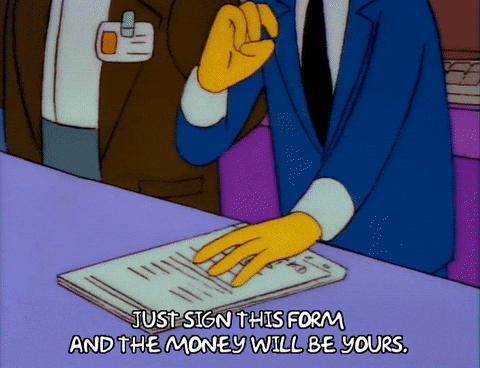How To: Optimize Your Budget to Generate Over 250K in the Next 10 Years (Step by step guide)
At Investing Hero, we aim to provide the best investing basics. To support this, some of the products featured in articles will generate an affiliate commission which helps pay to run this website. However, this doesn’t influence our evaluations. Our opinions are our own. The information provided on Investing Hero is for informational purposes only. Please read our disclaimer for more.
In part one of this series we outlined how to setup a simple budget plan to gain an awareness of your financial situation on a monthly basis. Once you’ve worked through this process, the next step is all about optimizing your existing expenses.
The results of this exercise will depend on your circumstances (e.g. if you have a mortgage and life insurance) but these figures are certainly possible, and based on a personal process I myself worked through with great success.
250K sounds like quite a lofty target, but as I mentioned results will vary considerably based on you own circumstances. There are a few assumptions here. To hit 250K, you’ll need to optimize a lot of the examples listed – otherwise this figure will obviously be a lot lower. But it’ll be a fun exercise to see what you can reach. Even 25K would be a result though, right?
Ok, that’s the disclaimer out the way to calm the trolls in the comments section at least 🙂
By the end of this article you will learn how to optimise your spending and expenses to free up considerable savings, which when invested will significantly impact your future wealth in 10 years time.
Lets get started.
What can you optimize in a budget?
There are few different opinions out there on optimizing a budget, which typically fall into two main camps.
One sides on reducing your small expenses, typically the daily transactional items such as your morning coffee or avocado on toast at the weekend. The other is on the mid to bigger sized items, like your rent, salary and insurance payments.
Investing Hero is focused on the later – Focusing first on the bigger ticket items.
By firstly addressing your bigger ticket items, because over the long term, these have a far greater impact on your financial stability and investing ability than 5 CHF coffees on the way to work. Not to say we don’t recommend looking at those too, but they are further down the list.
It’s important to note when looking at items to optimize you need to take a long-term view on the impact they will have.
For example, if you just look at the monthly cost of your car insurance or TV bill, it’s a lot harder to motivate yourself to take action and make the change. The monthly amount seems insignificant.
1. First, forecast this potential saving out over 10 years.
2. Then, forecast it invested with a 7% return over 10 years. Use this tool to do that.
Why 7%?
That’s the historical average return of the stock market for the last 100 years, and while we don’t know what the future holds, over a 10 year period we can expect to get at least close to that sort of return if you had the money invested.
Running these calculations makes the process that much easier to quantify the small, seemingly insignificant, changes you are making today and the impact they’ll potentially have in 10 years’ time.
Let’s take an example by optimizing your home TV and internet package.
With Swisscom you have the ‘Medium’ package, at 120 CHF/mth:

After reviewing your spending habits, maybe you feel this isn’t something you love spending money on (who really needs 270 TV channels anyway?) and the TV channels and internet speed in the ‘Small’ package is enough for your needs, at 75CHF/mth:

That’s a 45HF/mth cost saving, or 540 CHF/year. Over 10 years, that’s a cash saving of 5.4K CHF. However, invested over the same period with a 7% interest rate, and this grows to 7.4K CHF. Use this tool to run your own simulations.
Mouse over the line graph below to see how this grows over time:
And here’s how those numbers add up over a 10 year period:
| Years | Total Contributions | Invested over 10yrs @ 7% |
| Year 0 | 0.00 | 0.00 |
| Year 1 | 540.00 | 540.00 |
| Year 2 | 1080.00 | 1117.80 |
| Year 3 | 1620.00 | 1736.05 |
| Year 4 | 2160.00 | 2397.57 |
| Year 5 | 2700.00 | 3105.40 |
| Year 6 | 3240.00 | 3862.78 |
| Year 7 | 3780.00 | 4673.17 |
| Year 8 | 4320.00 | 5540.29 |
| Year 9 | 4860.00 | 6468.11 |
| Year 10 | 5400.00 | 7460.88 |
7.4K CHF for something I didn’t care about in the first place. That’s a big dent in the kids university tution fees – not bad for simply changing your TV package.
Run this exercise for each item in your budget you are looking to optimize and you’ll quickly start to see how this can impact your future wealth.
Here are a few more ideas to look at next:
Mortgage.
Mortgage rates are historically low right now, so if you have an existing mortgage from a few years back, there will be room to optimize your interest rate come renewal time.
The important point is to get multiple offers and not just accept a new term from your existing bank, so check your contract and note the contract renewal date before it’s too late.
As we’ve seen in the Swisscom TV package example above, a modest rate improvement over a 10 year time frame will have a considerable impact on your wealth.
| Mortgage amount | Interest Rate | Monthly payment | Total per year | Difference per year | Difference in 10years |
| 750K CHF | 1.0% | 625 CHF | 7500 CHF | – | – |
| 750K CHF | 1.6% | 1000 CHF | 12,000 CHF | + 4500 CHF | + 45,000 CHF |
In this case, that monthly difference of 375 CHF invested over 10years, assuming a 7% return, will grow to over 62K CHF.
Rent.
If you really want to save on rent – you obviously must consider moving to a smaller (and potentially less desirable) sized place, and deferring the idea of moving to a ‘bigger place’ just to have extra rooms.
Outside of downsizing, rent is a tricky one to optimize as we are emotionally attached and moving is a big undertaking. Personally, we found no real gain here as we wanted to stay in our town, and the downsizing options were limited for us.
If you don’t plan on moving, it’s worth checking the reference interest rate (currently 1.5% at time of writing) published each quarter by BWO (Federal Office for Housing) to see if you have a difference in your rental agreement. If the rate decreases, so should your rent. But you need to request this by sending a registered letter to the landlord.
You might get nothing back. You might get 300 CHF back on a modest calculation. Without ever asking however, you might miss out on another little nugget which could have grown to just over 4K CHF invested. It’s worth a shot. I’ve included it here on the list because it’s very easy to do, and literally takes all of five minutes to complete – so send it off and forget about it.
If you do decide to downsize in the name of building future wealth – then all credit to you! You could be looking at a 2-300 CHF per month rent reduction, potentially more, which adds up considerably with everything else being equal – 36K CHF in savings, or 49.7K CHF after that investment has compounded the returns at 7%.
Be it your mortgage or your rent – as you can see above, there are potentially some significant savings and future investment growth if the time and situation is right for you. Don’t miss out if the time is right.
Food.
With a growing family our 180-200CHF/week on food has become the norm at the mainstream (Migros, Coop) supermarket in Switzerland for us. Despite the special deals and bulk buys, it always seems to hover around that price point.

The convenience of shopping at the same place every week is one less thing to worry about. You can collect points, you know the products and layout of the building, you know where to park – the prices seem ok, and it’s easy to get it done in an hour and move on with your life.
But switch this up to Lidl or Aldi, and the cost savings might surprise you. A 180 CHF shop becomes 100 CHF quite easily.
And guess what? You don’t starve. It tastes fine. And you’ve found a nice little addition to your nest egg.
Try it twice a month. One week on, one week off.
Based on our example we saved 160CHF/mth, which again over the long term is 19K CHF saved, or 26.5K CHF invested – for choosing a different supermarket twice a month.
Insurances.
Generally in Switzerland we are over insured. Policies overlap, contracts auto renew and get forgotten. Take the time to comb through the details of your policy contracts and ensure you really need it, and that you have no overlap with other contracts you have.
For example, with a credit card, did you know purchases made (including items such as flights, hotels etc) are insured for cancellations?
Check your individual details.
Through this exercise, we found a travel insurance policy which was redundant – saving us around 280 CHF a year. Not a huge amount, but every little helps. Factor that change invested over 10 years vs. ‘doing nothing’ and it’s another win for the investment pot of 3.8K CHF.
So, print out a cancellation template letter, send it via registered post and get it cancelled if you see the opportunity. Set reminders in your calendar to review these insurances each year to keep your premiums competitive and relevant to your life circumstances.
Life insurance bundled into a pillar 3a.
A pillar 3a is an effective vehicle to reduce your tax rate and commit to a regular savings contribution (max. 6,826 CHF per year) which can be deducted from your annual tax return.
They generally come in two flavours – through a bank or insurance company.
While the bank will charge a minimal interest rate in today’s climate, it’s a simple and straightforward process that will offer you flexibility should you wish to change in the future.
You can also have your contributions invested through a range of funds offered through the bank, however be mindful of the fees this may incur. And be aware of the latest and greatest marketing material from the bank pushing new funds or pillar 3a investment strategies, question the total fees and amount you’ll be paying.
As mentioned above, insurance companies also offer options to manage your pillar 3a. Insurance companies are not all evil and bad, but be very sceptical of committing to a long term contract – you’ll be locked in and might be better off elsewhere.
Extreme caution should be exercised if you are transacting and communicating any of this through a broker, financial advisor or middle man. It’s in their interest to sell these products. They’ll take their cut and generate themselves a healthy commission – but might not be putting your best interests first.

Common practice, unfortunately, is to bundle a ‘must have’ death and disability insurance premium into your pillar 3a contract.
Your contract typically won’t specify the amount of your contributions going into this – the financial advisor won’t be transparent, and the insurance company won’t make it easy to get the information. Persistence is key here, keep chasing them to provide the information.
Naively I fell for this and trusted the financial advisor to look after my interests. I didn’t take the time and effort to go into the details of the contract, it was all too confusing at the time. As a result, I found 20% of my contribution was going toward such death and disability insurance, which amounted to over 850 CHF per year bound into a 35 year contract.
That’s nearly 30K in insurance fees over the contractual term, with zero interest or growth on the investment.
Clearly, my interests had not been put first.
Running the numbers here with a greater awareness and hindsight is horrifying – but we found it early and took action to rectify the situation. By taking that 850 CHF now and investing over the same contract period, we can estimate a return in the region of 117K CHF. I’m glad to have found it now.
Bundling this into your pillar 3a is simply not necessary and should be cancelled as soon as possible.
While you’ll forfeit some of your previous pillar 3a contributions due to breach of contract, don’t fall for the sunken cost fallacy and the opportunity cost of holding such a contract for 35 years.
Cancel it, learn from it, and move on with your life.

By all means take out a separate death and disability insurance policy, but keep it separate from your pillar 3a and purchase it directly without the salesman in the middle.
Car.
Unless you own a vintage Ferrari Dino, cars are not an asset. They will silently bleed thousands of CHF from you over the years. But I get it, you need a car. But it’s a great area to look at optimizing.
If you want to be wealthy later, for now your car should ideally be Japanese, at least 3 years old and be owned for the long term.
Service it, change the oil if you can battle the mental boredom and avoid falling into the ‘keeping up with the neighbours’ trap – it’ll provide at least a decade of trouble free and cost-efficient motoring.
Speaking from personal experience, we switched from a thirsty petrol engine VW to a similar spec’d Japanese version and are seeing significant monthly cost savings.
Excluding car depreciation, but factoring in fuel, insurance and servicing costs this switch has amounted to around 120 CHF/mth – which works out to just under 20K CHF after 10 years invested in the stock market.
You 🙂
This should probably be top of the list, but I’ve saved the best ‘till last – you!
It’s easy to overlook the fact that investing in yourself is absolutely critical in this process and will have significant impact on your future wealth.

The more you learn, read and educate yourself the better, and not just on financial investing topics.
By undertaking additional training relevant to your day job, gaining extra qualifications and taking on more responsibilities in the workplace you will position yourself to not only grow as an individual, but drastically improve your talent profile and earnings potential with your employer and future career.
Getting into the details on the personal development track is outside the scope of this blog post. But taking an example of earning 100K CHF a year, and you get results at work (or change roles, companies etc) and manage to achieve a 8% salary increase, that extra 8K CHF a year would result in 110.4K CHF after 10years invested.
To put it another way, after 10 years your investment has covered more than an entire year of working at your older salary, from a single pay rise!
…And for simplicity’s sake that excludes the additional pension contributions that’ll also increase and compound with your ‘new’ salary, so the figure is even higher.
I appreciate we can’t expect to get 8% salary increases every year, if ever, but the example above shows that even some modest increases have a much greater impact in the long term.
Additionally, if you can switch to working one day a week from home you’ll see a nice addition to your investment plan – 4 days a month means 80 CHF/mth saved on train tickets and the company canteen results in over 13.2K CHF invested.
Don’t forget about these indirect perks when changing jobs or discussing a salary increase.
The details of getting such a raise are outside the scope of this blog post, but by focusing on the value you are bringing to your job, setting business goals and smashing your targets, you will be in a good position for those ‘scary salary review meetings’ or changing company to improving your future wealth.
Adding up our big-ticket items.
I hope the above has helped give you some perspective on your choices, and what these might do in the long term. The lack of action in some areas of our lives can be crippling to our ability to build long term wealth.
While I appreciate not all these categories to optimize will be relevant to you, I’m sure there are a few takeaways. We’ve used 10 years in the examples throughout, but forecasting even further, such as 15 years, the compound interest really starts to snowball if you stick with the plan.
Examples outlined in this article, excluding inflation and taxes:
| Item | Gained per month | Gained per year | Gained over 10yrs | Invested over 10yrs @ 7% |
| Mortgage | 375 | 4500 | 45000 | 62174 |
| Food | 160 | 1920 | 19200 | 26527 |
| Insurances | 94 | 1130 | 11300 | 15584 |
| Car | 120 | 1440 | 14400 | 19895 |
| Salary increase | 666 | 8000 | 80000 | 110421 |
| Home office | 80 | 960 | 9600 | 13263 |
| TV & Internet | 45 | 540 | 5400 | 7460 |
| TOTAL | 1,540 CHF | 18,490 CHF | 184,900 CHF | 255,324 CHF |
If you tackle some of the bigger items you can see how you’ll quickly reach 6 figures in the future, and the sooner you do it, the sooner you’ll get there.
Closing thoughts.
For those that read this blog post to the very end, congrats and thank you! If you can commit to reading this, the first steps in optimizing your budget plan will be easy in comparison.
Above all else, the biggest hurdle is simply taking action and starting. Start with your post-it note outlined in part one, and work through the process. List your expenses and look at how you can optimize things to get started on building that CHF nest egg in 10 years, and forecast these figures based on different investment returns.
Just get started and keep the momentum going.
What did you think of the budget optimization process outlined here? What areas have you successfully optimized?
Let us know in the comments below.


